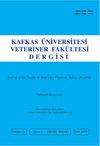小牛冠状病毒肺炎综合征的超微结构和免疫组织化学研究
IF 0.9
4区 农林科学
Q3 VETERINARY SCIENCES
引用次数: 1
摘要
本研究的目的是对新生儿和生长小牛自发性肺炎综合征的结构和形态发生进行调查,以确定疾病形态发生的一些结构特征。该研究对来自该国4个地区6个牛场的370头24小时25天的小牛进行了研究。为了快速检测病原体的抗原和病毒,采用Multiscreen Ag ELISA、Bovine respiratory, Pulmotest respiratory tetra ELISA试剂盒对BoНV-1、BVDV、BRSV进行抗原诊断,并对组织裂解物进行BPI-3夹心检测(BIOX Diagnostics,比利时)和Rainbow calf scour 5 BIO K 306对牛粪便中轮状病毒、冠状病毒、大肠杆菌F5、细小隐孢子虫和产气荚膜梭菌进行检测(BIOX Diagnostics,比利时)。在5%的病例中,对肺炎小牛肺组织裂解物的实验室抗原检测发现了BoНV-1、BVDV、BRSV和BPI-3的合并感染。所采用的抗原性、超微结构和病毒学诊断方法表明,它们可以成功地用于诊断幼年小牛的肺部和胃肠道病毒感染。肺和肠组织的电镜和免疫组织化学方法也很重要,适用于诊断和与其他常见疾病的鉴别诊断,如IBR、BVD、BRSV、溶血性曼海姆病、小隐孢子虫、BRV和大肠杆菌K99 (F5)。本文章由计算机程序翻译,如有差异,请以英文原文为准。
Ultrastructural and immunohistochemical investigations in calves with coronavirus pneumoenteritis syndrome
The aim of present studies was the structural and morphogenetic investigation of spontaneous pneumoenteritis syndrome in newborn and growing calves with regard to confirmation of some structural features of disease morphogenesis. The research was done with 370 calves from 6 cattle farms in 4 regions of the country, at the age of 24 h 25 days. For rapid antigenic and viral detection of pathogens, Multiscreen Ag ELISA, Bovine respiratory, Pulmotest respiratory tetra ELISA kit for antigenic diagnosis of BoНV-1, BVDV, BRSV, and BPI-3 sandwich test for tissue lysates (BIOX Diagnostics, Belgium) and Rainbow calf scour 5 BIO K 306 Detection of Bovine Rotavirus, Coronavirus, Escherichia coli F5, Cryptosporidium parvum and Clostridium perfringens in bovine stool (BIOX Diagnostics, Belgium) were used. In 5% of cases, laboratory antigenic tests of lung tissue lysates from pneumonic calves detected co-infections with BoНV-1, BVDV, BRSV and BPI-3. The utilised antigenic, ultrastructural and virological diagnostic methods allowed concluding that they could be successfully used in the diagnostics of pulmonary and gastrointestinal viral infections in juvenile calves. Electron microscopy and immunohistochemical methods of lung and intestinal tissue are also important and applicable for diagnostics and in differential diagnostic recognition of the condition from other common diseases as IBR, BVD, BRSV, Mannheimia haemolytica, Cryptosporidium parvum, BRV and E. coli K99 (F5).
求助全文
通过发布文献求助,成功后即可免费获取论文全文。
去求助
来源期刊
CiteScore
1.50
自引率
14.30%
发文量
56
审稿时长
3-6 weeks
期刊介绍:
The journal publishes full-length research papers, short communications, preliminary scientific reports, case reports, observations, letters to the editor, and reviews. The scope of the journal includes all aspects of veterinary medicine and animal science.

 求助内容:
求助内容: 应助结果提醒方式:
应助结果提醒方式:


